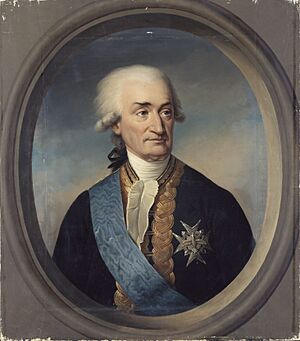Luc Urbain du Bouëxic, comte de Guichen facts for kids
Quick facts for kids
Luc Urbain du Bouëxic, comte de Guichen
|
|
|---|---|

Luc Urbain du Bouexic, comte de Guichen (1712–1790); posthumous portrait by Paulin Guérin, 1832.
|
|
| Born | 21 June 1712 Fougères, Ille-et-Vilaine, Kingdom of France |
| Died | 13 January 1790 (aged 77) Morlaix, Kingdom of France |
| Allegiance | |
| Service/ |
|
| Years of service | 1730–1783 |
| Rank | Lieutenant général des armées navales |
| Battles/wars | |
| Awards | |
Luc Urbain du Bouëxic, comte de Guichen (born June 21, 1712, died January 13, 1790) was a brave French admiral. He led French ships in important battles against the British. These battles happened during the American War of Independence. Some famous battles he fought in were the First Battle of Ushant in 1778 and the Battle of Martinique (1780) in 1780.
Contents
Luc Urbain du Bouëxic was born in Fougères, France. He joined the French Navy in 1730. His first role was a Garde-Marine, which was a junior officer position. He worked hard and was promoted to lieutenant in 1746.
In 1748, Guichen showed his skill in battle. He fought five times against stronger British forces. At the time, he was protecting a group of merchant ships. These ships were traveling from the Caribbean back to France. For his bravery, he was made a Knight in the Order of Saint Louis that same year.
In 1755, he joined an important mission. He sailed on the 70-gun ship Héros. This mission tried to help the city of Louisbourg, but it was not successful. In 1775, he was given command of the frigate Terpsichore. He was promoted to Captain in May 1756. A year later, he became a Chef d'Escadre, which is a senior naval rank.
Major Battles and Commands
The First Battle of Ushant (1778)
France decided to join the American War of Independence. Guichen was then put in charge of the Channel fleet. He led this fleet in the First Battle of Ushant. This battle took place on July 27, 1778. His own ship, the 104-gun Ville de Paris, was very close to the main fleet's flagship, Bretagne. In March 1779, he was promoted to Lieutenant Général des Armées navales. This meant he was a very high-ranking admiral. He commanded the front part of the combined French and Spanish fleet from June to September that year.
The Battle of Martinique (1780)
In January 1780, Guichen sailed to the West Indies. He led a powerful group of warships. On April 17, near Martinique, Guichen's fleet met a British force. This British force was led by Admiral George Brydges Rodney. This meeting led to the Battle of Martinique (1780). During the fight, both Rodney's ship, Sandwich, and Guichen's ship, Couronne, were cut off from their main fleets. They had to fight very hard on their own.

After this, two more battles happened. They were on May 15 and May 19, 1780. None of these battles had a clear winner.
The hurricane season was coming in July. So, Guichen left the West Indies and sailed back to France. He arrived in Cadiz in September. He was also protecting 95 merchant ships. Sadly, his second-in-command, Sade de Vaudronne, died at sea as the fleet arrived.
The 1781 Action in the Bay of Biscay
In December 1781, Guichen had a new mission. He was to carry supplies and more soldiers to the West Indies. On December 12, British Admiral Richard Kempenfelt found Guichen's ships. This happened in the Bay of Biscay. There was a fog, but it cleared for a short time. Guichen's warships were not in a good position to protect the supply ships. Kempenfelt attacked the transport ships right away. This battle is known as the Second Battle of Ushant.
Kempenfelt captured twenty of Guichen's transport ships. The other ships had to go back to port. Guichen's mission had failed. He also returned to port. He did not have another chance to win a major victory during the rest of the war. However, he was present when Lord Howe helped the city of Gibraltar.
Legacy and Recognition
Luc Urbain du Bouëxic, comte de Guichen, is remembered in several ways.
- Guichen Bay in South Australia was named after him.
- A French warship from the First World War, the Guichen, was also named in his honor.
In 1785, Guichen was chosen as an international member of the American Philosophical Society. This is a famous group in Philadelphia, USA.


